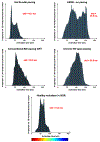A New Electromechanical Wave Imaging Dispersion Metric for the Characterization of Ventricular Activation in Different Cardiac Resynchronization Therapy Pacing Schemes
- PMID: 36049009
- PMCID: PMC9975111
- DOI: 10.1109/TBME.2022.3203653
A New Electromechanical Wave Imaging Dispersion Metric for the Characterization of Ventricular Activation in Different Cardiac Resynchronization Therapy Pacing Schemes
Abstract
Conventional biventricular (BiV) pacing cardiac resynchronization therapy (CRT) is an established treatment for heart failure patients. Recently, multiple novel CRT delivering technologies such as His-Bundle pacing have been investigated as alternative pacing strategies for optimal treatment benefit. Electromechanical Wave Imaging (EWI), a high frame-rate echocardiography-based modality, is capable of visualizing the change from dyssynchronous activation to resynchronized BiV-paced ventricles in 3D. This proof-of-concept study introduces a new EWI-based dispersion metric to further characterize ventricular activation. Patients with His-Bundle device implantation (n = 4), left-bundle branch block (n = 10), right-ventricular (RV) pacing (n = 10), or BiV pacing (n = 15) were imaged, as well as four volunteers in normal sinus rhythm (NSR). EWI successfully mapped the ventricular activation resulting from His-Bundle pacing. Additionally, very similar activation patterns were obtained in the NSR subjects, confirming recovery of physiological activation with His pacing. The dispersion metric was the most sensitive EWI-based metric that identified His pacing as the most efficient treatment (lowest activation time spread), followed by BiV and RV pacing. More specifically, the dispersion metric significantly (p < 0.005) distinguished His pacing from the other two pacing schemes as well as LBBB. The initial findings presented herein indicate that EWI and its new dispersion metric may provide a useful resynchronization evaluation clinical tool in CRT patients under both novel His-Bundle pacing and more conventional BiV pacing strategies.
Figures




Similar articles
-
Cardiac Resynchronization Therapy Response Assessment with Electromechanical Activation Mapping within 24 Hours of Device Implantation: A Pilot Study.J Am Soc Echocardiogr. 2021 Jul;34(7):757-766.e8. doi: 10.1016/j.echo.2021.02.012. Epub 2021 Mar 4. J Am Soc Echocardiogr. 2021. PMID: 33675941 Free PMC article.
-
Efficacy on resynchronization and longitudinal contractile function comparing His-bundle pacing with conventional biventricular pacing: a substudy to the His-alternative study.Eur Heart J Cardiovasc Imaging. 2023 Dec 21;25(1):66-74. doi: 10.1093/ehjci/jead181. Eur Heart J Cardiovasc Imaging. 2023. PMID: 37490036 Clinical Trial.
-
Remarkable response to cardiac resynchronization therapy via left bundle branch pacing in patients with true left bundle branch block.Clin Cardiol. 2020 Dec;43(12):1460-1468. doi: 10.1002/clc.23462. Epub 2020 Sep 22. Clin Cardiol. 2020. PMID: 32960993 Free PMC article.
-
Discussion of LBBP synchronization effects in HF patients with LBBB and comparison with BiV-CRT.Heart Fail Rev. 2022 Nov;27(6):2181-2186. doi: 10.1007/s10741-021-10213-7. Epub 2022 Mar 14. Heart Fail Rev. 2022. PMID: 35286573 Review.
-
His Bundle Pacing for Cardiac Resynchronization.Card Electrophysiol Clin. 2018 Sep;10(3):511-517. doi: 10.1016/j.ccep.2018.05.010. Epub 2018 Jul 21. Card Electrophysiol Clin. 2018. PMID: 30172288 Review.
Cited by
-
Electromechanical Cycle Length Mapping for atrial arrhythmia detection and cardioversion success assessment.Comput Biol Med. 2023 Sep;163:107084. doi: 10.1016/j.compbiomed.2023.107084. Epub 2023 May 30. Comput Biol Med. 2023. PMID: 37302374 Free PMC article.
-
Long-term atrial arrhythmia characterization and treatment efficacy evaluation using non-invasive echocardiography-based electromechanical cycle length mapping: a case series.Eur Heart J Case Rep. 2024 Jul 11;8(8):ytae303. doi: 10.1093/ehjcr/ytae303. eCollection 2024 Aug. Eur Heart J Case Rep. 2024. PMID: 39104515 Free PMC article.
-
High volume-rate echocardiography for simultaneous imaging of electromechanical activation and cardiac strain of the whole heart in a single heartbeat in humans.PLoS One. 2024 Dec 27;19(12):e0313410. doi: 10.1371/journal.pone.0313410. eCollection 2024. PLoS One. 2024. PMID: 39729494 Free PMC article.
References
-
- Abraham WT et al. “Cardiac resynchronization in chronic heart failure”, New England Journal of Medicine, vol. 346, no. 24, pp. 1845–1853, Jun. 2002. - PubMed
-
- Cleland JGF et al. “The effect of cardiac resynchronization on morbidity and mortality in heart failure”, New England Journal of Medicine, vol. 352, no. 15, pp. 1539–1549, Apr. 2005. - PubMed
-
- Ali H et al. “Para-hisian pacing: new insights of an old pacing maneuver”, JACC: Clinical Electrophysiology, vol. 5, no. 11, pp. 1233–1252, Nov. 2019. - PubMed
-
- Beer D et al. “Clinical outcomes of selective versus nonselective His bundle pacing”, JACC: Clinical Electrophysiology, vol. 5, no. 7, pp. 766–774, Jul. 2019. - PubMed
Publication types
MeSH terms
Grants and funding
LinkOut - more resources
Full Text Sources
Research Materials

